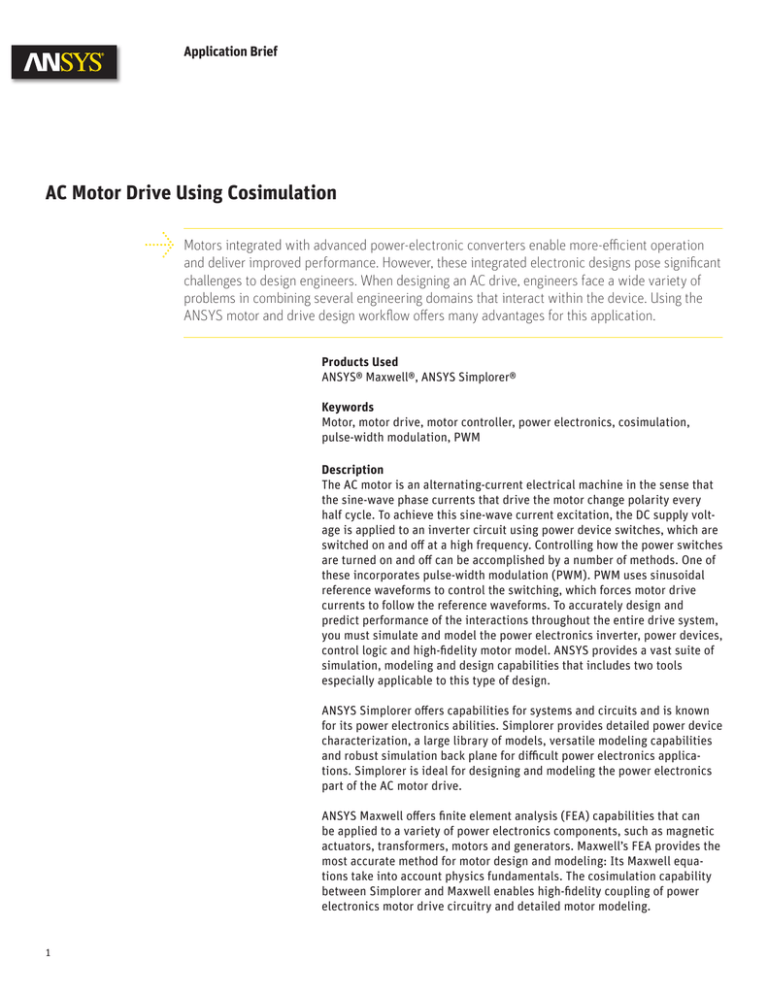
Application Brief
AC Motor Drive Using Cosimulation
Motors integrated with advanced power-electronic converters enable more-efficient operation
and deliver improved performance. However, these integrated electronic designs pose significant
challenges to design engineers. When designing an AC drive, engineers face a wide variety of
problems in combining several engineering domains that interact within the device. Using the
ANSYS motor and drive design workflow offers many advantages for this application.
Products Used
ANSYS® Maxwell®, ANSYS Simplorer®
Keywords
Motor, motor drive, motor controller, power electronics, cosimulation,
pulse-width modulation, PWM
Description
The AC motor is an alternating-current electrical machine in the sense that
the sine-wave phase currents that drive the motor change polarity every
half cycle. To achieve this sine-wave current excitation, the DC supply voltage is applied to an inverter circuit using power device switches, which are
switched on and off at a high frequency. Controlling how the power switches
are turned on and off can be accomplished by a number of methods. One of
these incorporates pulse-width modulation (PWM). PWM uses sinusoidal
reference waveforms to control the switching, which forces motor drive
currents to follow the reference waveforms. To accurately design and
predict performance of the interactions throughout the entire drive system,
you must simulate and model the power electronics inverter, power devices,
control logic and high-fidelity motor model. ANSYS provides a vast suite of
simulation, modeling and design capabilities that includes two tools
especially applicable to this type of design.
ANSYS Simplorer offers capabilities for systems and circuits and is known
for its power electronics abilities. Simplorer provides detailed power device
characterization, a large library of models, versatile modeling capabilities
and robust simulation back plane for difficult power electronics applications. Simplorer is ideal for designing and modeling the power electronics
part of the AC motor drive.
ANSYS Maxwell offers finite element analysis (FEA) capabilities that can
be applied to a variety of power electronics components, such as magnetic
actuators, transformers, motors and generators. Maxwell’s FEA provides the
most accurate method for motor design and modeling: Its Maxwell equations take into account physics fundamentals. The cosimulation capability
between Simplorer and Maxwell enables high-fidelity coupling of power
electronics motor drive circuitry and detailed motor modeling.
1
AC Motor Drive Using Cosimulation
Figure 1. AC motor drive system in Simplorer using control blocks for reference voltage and highfrequency triangular waveform, state machine for control logic, power electronics inverter using
system-level IGBTs, and finite element Maxwell motor model
Figure 1 shows the motor drive system in Simplorer. The system is divided
into four sections: reference voltage and high-frequency triangle waveform,
state machine, power-electronics inverter, and Maxwell FEA motor model.
The reference voltages are compared to the high-frequency triangular waveform as shown in Figure 2. There are three reference sinusoidal waveforms
because the motor is a three-phase AC machine. The state machine implements the PWM control logic design that controls turning on and off the
power device switches. When the reference voltage is greater than the triangular waveform, the state machine generates a 1; if the reference voltage
is less than the triangular waveform, the state machine generates a 0. One
of the six PWM signals generated by the state machine is shown in Figure 3.
Figure 2. PID control with step response and AC response
2
Figure 3. Signal processing example of current flowing between controlled
rectifier and three-phase load demonstrates that a signal can be analyzed at a
specified sampling frequency.
AC Motor Drive Using Cosimulation
Figure 4. Three-phase current waveforms generated by inverter to drive Maxwell
motor model
Figure 5. Torque produced by Maxwell FEA motor model
Simplorer provides several levels of power device modeling, from system
level to very detailed dynamic switching characteristic levels. The systemlevel IGBTs in this example are used to quickly evaluate the digital control logic required when a 1 turns on the IGBT switch and 0 turns off the
IGBT. The PWM signals switch on and off the power-electronics IGBTs of
the inverter to generate the desired sinusoidal currents to drive the AC
motor. Figure 4 shows the three-phase current waveforms generated by
the inverter. Notice that the currents have ripple due to PWM modulation
(which is seen in actual test data). Figure 5 shows the torque produced by
the Maxwell FEA motor model. The motor windings are energized by the
currents generated from the inverter, producing a rotating magnetic field
that interacts with the rotor magnets and thus producing a usable mechanical torque. Figure 6 shows the magnetic flux density and flux line distribution in the motor cross section. Simplorer–Maxwell cosimulation enables
the user to have access to ield results while taking into account the realistic
drive currents generated by the inverter.
Figure 6. Line voltages and motor currents in machine control example (from Figures 3 and 4)
3
AC Motor Drive Using Cosimulation
Summary
To design an AC motor drive, it is important to have the ability to model and
simulate the different sections and their interactions. An AC motor drive
system that includes control logic, power electronics inverter, and FEA
motor model was shown by using Simplorer–Maxwell cosimulation capability. This cosimulation allows the highest level of accuracy and predicts
realistic voltage and current generated from the inverter drive, and the
performance of the motor.
ANSYS, Inc.
Southpointe
275 Technology Drive
Canonsburg, PA 15317
U.S.A.
724.746.3304
ansysinfo@ansys.com
© 2014 ANSYS, Inc. All Rights Reserved.
ANSYS, Inc. is one of the world’s leading engineering simulation software providers. Its technology has enabled customers to predict with accuracy that their product designs will thrive in the real world. The company offers a common platform of
fully integrated multiphysics software tools designed to optimize product development processes for a wide range of industries, including aerospace, automotive,
civil engineering, consumer products, chemical process, electronics, environmental, healthcare, marine, power, sports and others. Applied to design concept,
final-stage testing, validation and trouble-shooting existing designs, software from
ANSYS can significantly speed design and development times, reduce costs, and
provide insight and understanding into product and process performance.
Visit www.ansys.com for more information.




